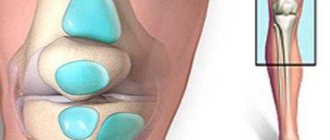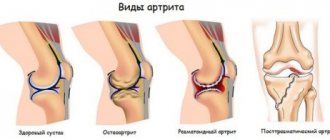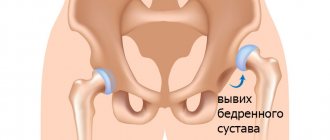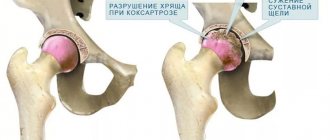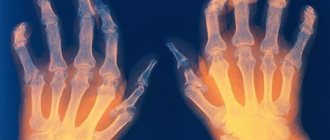Arthritis of the hip is a disease characterized by inflammation in the articular surfaces of the acetabulum and head of the femur. A synonym for this disease is coxitis. Most often, this disease affects older people who have crossed the age of 65. However, currently the disease is rapidly “rejuvenating”, which makes it possible to diagnose it in young people and even children.
According to medical statistics, up to 1% of the population suffers from hip arthritis, which is a very impressive figure.
What is arthritis
A disease such as arthritis is always accompanied by inflammatory processes in the joints. And the hip is no exception. This disease will always be progressive if it is not given proper treatment. Therefore, sooner or later deformation processes will begin in the inflamed joint.
Arthritis of the hip joint (symptoms and treatment are described in this article) usually begins to develop when other connective tissues of the body, such as the hands, knees and other large joints, are also damaged.
Most often, this pathology develops in people who have reached old age. However, every year the disease develops earlier and earlier. Today you can even find children complaining of incredible joint pain.
What are the symptoms of the disease and its types?
Arthritis is characterized by inflammation of the tissues located between the pelvic and femur bones. Inflammation covers the inner walls of the joint cavity. Arthritis of the hip joint (also called coxitis) is a serious disease; it does not stand still, but develops and progresses all the time. If neglected, the consequences will be serious, including disability.
According to scientific research, the disease occurs mainly in people of advanced age, and it is diagnosed in women much more often than in men. But sometimes the diagnosis of coxitis is made at a very young age, and children also suffer from it.
The disease affects either one half of the hip joint, or both parts at the same time. Taking this into account, bilateral or unilateral types are distinguished. The bilateral form does not appear immediately; initially, disturbances are observed in one joint, then arthritis develops in the joint on the other side.
Arthritis of the hip joint or coxitis is an inflammatory disease of joint tissues that occurs as a response of the body to the penetration of bacteria or viruses into tissues.
Arthritis of the hip joints: symptoms
This disease has pronounced symptoms, which are very easy to identify. Since the disease is inflammatory in nature, its symptoms are directly related to this. Arthritis of the hip joint, the symptoms and treatment of which are described in this article, is always accompanied by pain, swelling, and severe limitation in movement. Since the hip joint is the largest in the body, very often its damage is also accompanied by other symptoms. The person's body temperature may rise. Headaches, nausea, vomiting and loss of appetite are possible.
Symptoms of inflammation in the hip joint
Symptoms of arthritis in the largest joint of the human skeleton have some differences depending on the location of the source of inflammation, shape and provoking factors. At the initial stage of development, the main symptoms of any type of arthritis of the hip joint appear in the form of pain of varying degrees of intensity . The pain can be periodic or constant and quite intense. They tend to periodically fade or become dull, which forces patients to put up with them and ignore them. This is the insidiousness of the disease, since the temporary absence of pain does not mean that the disease has receded. If there is no professional treatment, the pathology develops and progresses.
Specific symptoms of arthritis, which differ depending on the type of disease, are as follows:
- Rheumatoid arthritis is characterized by symmetrical damage and even parallel development of inflammation in the joint. The main symptoms for this type are a feeling of morning stiffness in the hip joint, pain at the site of the inflammatory process and the formation of swelling.
- Purulent arthritis, as a rule, is accompanied by severe weakness, fatigue, fever and increased sweating. The pain is constant and may intensify with movement. The skin over the inflamed joint becomes purplish-red in color, and swelling forms in its place. The accumulation of pus in the affected joint can cause signs of intoxication.
- Symptoms of gouty arthritis include significant pain attacks over a period of time, sometimes up to 10 days . The affected joint becomes red and hot to the touch. There is also a decrease in mobility and limited motor functions.
- The psoriatic form tends to develop against the background of gout. It is distinguished by an asymmetrical lesion. At the same time, blue discoloration and the formation of roughness are noticeable in certain areas of the skin. The lower parts of the spinal column are often involved in the inflammatory process.
However, this disease is also characterized by some generalized symptoms that accompany it, regardless of the type. Among them are pain in inflamed joints of varying degrees of intensity and duration, stiffness and limited mobility of the hip joint, smoothness of natural folds in the buttocks and groin due to the formation of swelling.
Types of pain
In order to more accurately diagnose the disease, you need to pay attention to the type of pain. If the disease is subacute and acute in nature, then this indicates that pain will be constantly present and can be quite strong. Usually the joint swells and its mobility is very limited. At the same time, the general condition of the body deteriorates greatly. As a rule, after acute symptoms pass, arthritis smoothly passes into the chronic stage.
In this case, the pain may appear and disappear, so patients may simply not pay attention to the presence of such an ailment as arthritis of the hip joint. Symptoms and treatment are very important information that every person should familiarize themselves with in order to protect themselves from all sorts of negative consequences.
During the chronic stage of the disease, symptoms may appear and disappear. That is, in some periods the disease may subside, and in others it can begin to progress again. In any case, irreversible processes will occur in the body. If you do not eliminate this pathology, it can lead to disability.
Symptoms
All forms of coxitis have common symptoms:
- Pain in the groin area . It may get worse when you try to jerk your leg or make any other movement. Painful sensations can be dull, burning, or pulsating. In the first stages, unpleasant sensations hardly bother the person, but as the disease progresses they begin to intensify.
- Stiffness of movement - the motor activity of the affected leg is severely limited, the person experiences difficulty turning the leg.
- Lameness, changes in gait - if painful sensations occur, the patient may limp so that the unpleasant symptoms do not bother them.
- Limiting physical activity in the morning.
- Local increase in temperature in the affected area - the skin becomes hot to the touch.
- Increase in temperature of the whole body.
- Redness of the skin in the hip and groin area.
- Swelling.
- Swelling of the skin.
- Increasing the volume of the joint capsule.
- Weakness and general malaise.
Reasons for the development of the disease
Arthritis of the hip joint (symptoms and treatment are described in detail on this resource) can begin to develop depending on two types of factors: inflammatory and infectious.
Typically, the inflammatory form of this disease occurs due to improper functioning of the immune system, impaired metabolism, allergic reactions, as well as some genetic abnormalities, oncology and injury.
But infectious types of arthritis can occur when certain groups of infections are present in the body. It is very important to recognize parasites in time and begin treatment immediately.
Reasons for appearance
The most common causes of the disease are pathogenic microbes. Penetrating into the tissues of the joint, they provoke an inflammatory process, the formation of exudate (purulent deposits), and also, with their waste products, disrupt the composition of the synovial fluid.
It is microorganisms that selectively infect the most vulnerable tissues of the joint. Therefore, most often the disease in this joint develops from the synovial inner lining of the joint cavity.
Another etiological factor that provokes this abnormal condition of the joint is a consequence of trauma. Violations of tissue integrity are inevitably accompanied by swelling, which over time causes inflammation, first in the joint membrane, and then in the cartilage tissue. Later, the process spreads to the bones, which are part of the articular apparatus.
Read also: Arthritis of the knee joint treatment with medication
In addition, in medical practice, the following causes are diagnosed that influence the development of the disease:
- Anatomical changes in the entire elements of the joint or its individual components;
- The influence of excess weight in obesity;
- Consequences of intense training;
- Excessive physical activity;
- Orthopedic anomalies typical for young patients;
- Genetic factors.
Indirect factors affecting disorders in the physiology and anatomy of the hip joint, and causing its disease, may be autoimmune diseases, disorders of endocrine physiology, as well as inadequate composition of the diet, the predominance of harmful ingredients in food. In many cases, the disease develops as a secondary disease against the background of progressive diseases with inflammatory signs in the digestive tract. Being in close proximity to the source of inflammation, the joint runs the risk of becoming infected with pathogenic microflora.
Arthritis of the hip joint can also be provoked by other forms of the disease localized in other joints, as well as systemic lupus erythematosus, rheumatoid arthritis, and osteoarthritis.
Arthritis of the hip joint in children
Symptoms of this disease can appear even in the youngest category of the population. If in adults this disease is associated specifically with degeneration of bone tissue, then in children it develops under the influence of diseases accompanied by inflammatory processes.
Every year, this disease occurs more and more often in children, and at the same time its symptoms are more acute. The most dangerous is arthritis accompanied by purulent discharge. For children it can be fraught with very serious consequences. Cases that end in death cannot be excluded.
Arthritis of the left hip joint, just like the right, can also occur under the influence of tuberculosis. This condition occurs much more often in children than in adults. At the same time, it can occur without any pronounced symptoms. And pain can only appear during heavy physical exercise.
Please note that this disease very often occurs against the background of other pathological processes occurring in the body. Taking medications that reduce elevated body temperature can only make the symptoms less noticeable. But in reality, the inflammation will not disappear.
If at an early age you notice that the child cannot step on his feet, or he has a fear of walking, be sure to tell the specialist about it. It is necessary to begin treatment for such a serious illness as early as possible.
First aid
It is important to understand how to treat hip arthritis. If you experience severe pain, first of all, you need to be able to provide proper medical care. For this purpose, doctors recommend the use of anti-inflammatory non-steroidal drugs, such as Ibuprofen, Nise, Ortofen and others. Such medications not only relieve pain well, but also reduce inflammation. Please note that for children you need to use a smaller dosage of active substances. It is very important to immobilize the injured joint. Try to take a lying position. And don't try to develop the joint. This won't end well.
Correct treatment
In order for treatment to be as effective as possible, first of all, it is necessary to eliminate the very cause of the disease. And only after understanding why a disease such as hip arthritis began to progress in the body, drugs of the appropriate type can be prescribed.
Typically, depending on the etymology, antiallergic, antibacterial and immune medications are used, as well as drugs that improve metabolic processes in the body.
If non-steroidal anti-inflammatory drugs are ineffective, then they need to be replaced with more serious medications. Doctors usually prescribe glucocorticoid hormones to their patients, such as Dexamethasone and Prednisolone. In the most advanced cases, such drugs are injected directly into the joint itself.
If arthritis is accompanied by purulent processes, then experts may recommend treatment through surgery. Antibiotics may be injected into the joint cavity, or a drainage method may be performed. It all depends on the individual course of the disease.
Consequences
The ICD code “Arthritis of the hip joint” has the number M00-M99, M16. If you recognize this disease in time, then you have every chance to avoid serious complications. It is very important not to self-medicate, but to seek help from highly qualified specialists.
As the disease progresses, the groin and thigh muscles may begin to atrophy. If arthritis is left untreated for a long time, it can lead to fusion of the articular surfaces. This occurs due to prolonged immobility of the patient. By postponing treatment “until tomorrow”, you are increasingly at risk of starting to limp and losing full functionality. Cases ending in complete disability and death cannot be excluded.
Signs leading to an inflammatory process
The pathological reaction in the hip joint arises in the overwhelming majority due to infectious diseases. If there are infections in the human body (meningitis, tuberculosis, brucellosis, Lyme disease and other diseases), then they become the causes of arthritis of the hip joint.
Inflammation in the thigh can develop under the influence of allergies, ankylosing spondylitis, and intestinal pathologies.
Other joint inflammations do not have a very negative effect on the hip joint, sometimes appearing in the last stages of arthritis.
Infectious lesions occupy one of the first places among the causes of hip joint inflammation
Preventive measures
Modern treatment usually provides very good and lasting results. However, there are no methods that will help permanently prevent the development of this disease.
However, maintaining the right lifestyle will definitely help you. Maintain good hygiene, eat right and exercise regularly. Use special dietary supplements containing large amounts of vitamins and minerals. It is very important to take enough vitamin D and calcium. If you have any infection, even the most common cold, begin treatment immediately. Take care of your health, and then the risk of developing arthritis will be minimal. Be healthy and take care of yourself.
Preventive actions
If you have joint disease, it is very important to eat right and review your daily diet . It is necessary to eat as many fruits and vegetables as possible, but do not forget about meat. It is advisable to cook dishes such as jellied meat or jellied meat more often, since they contain the necessary source of substances for cartilage. It must be remembered that fatty meats are not suitable for this. It is best to prepare dishes from lean meats or fish. We must not forget about cereals and dairy products.
It is also necessary to try to lead an active lifestyle and give up bad habits . It is very important not to create conditions with increased load on the legs, but to minimize the load on the lower limbs. It is advisable to perform simple gymnastic exercises aimed at strengthening the joints.

